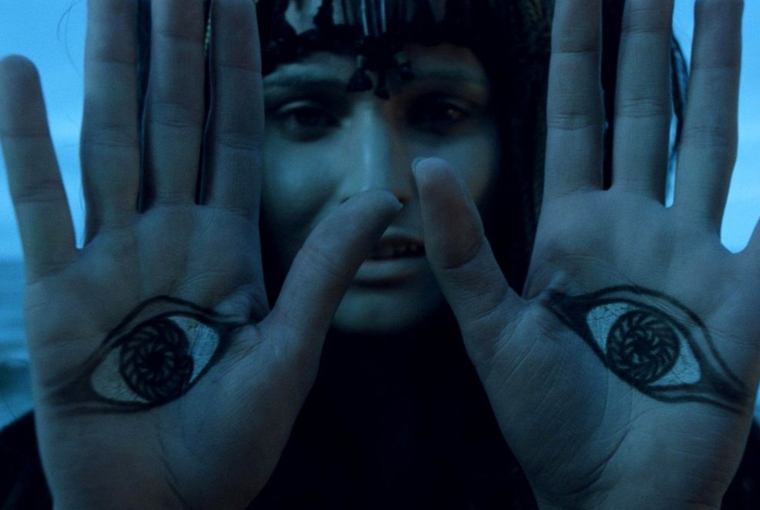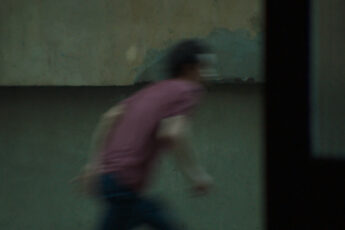The Problem of Communist Censorship
Kuba Mikurda’s Escape to the Silver Globe (Ucieczka na srebrny glob, 2021)
Vol. 121 (January 2022) by Lucian Tion
On the Silver Globe (Na srebrnym globie) went down in history as one of the could-have-beens of Polish cinema. A sci-fi extravaganza with a deeply personal touch – which critics dubbed a Polish version of Star Wars – the film was to be Andrzej Żuławski’s fourth feature, shot soon after the French hit That Most Important Thing: Love (L’important c’est de aimer, 1975) and his Polish productions The Devil (Diabeł, 1971) and The Third Part of the Night (Trzecia część nocy, 1972). Even though it allowed more than half of the principal photography on the film to be completed, the Polish government suddenly halted the production in 1978 and On the Silver Globe was not completed. Not until 1986, that is, when Żuławski, who had meanwhile travelled to France, was invited to return to Poland and finish it. In an irreverent gesture befitting his explosive character, however, the French-Polish auteur never acquiesced, deciding to solely add voice-over narration, which was recorded over footage of sunsets and cityscapes and added to the previous material. This was the version that, somewhat anticlimactically, saw the light of day in 1988 and travelled the festival and the regular distribution circuits thereafter.
In a strange redoubling of Jerzy Skolimowksi’s later reedit of another mutilated film, the 1967 Hands Up! (Ręce do góry), itself released after the director added a similar coda and additional footage in 1981, Żuławski’s On the Silver Globe (aided by the indispensible rumors that circulated around its production process) gained the fascinating aura that only Communist censorship and a volatile directorial temperament can bring to the art of filmmaking. While much has been made over the years of the political role this censorship played in the (stopping of the) film’s production, Kuba Mikurda’s documentary Escape from the Silver Globe carefully recreates the period in which Żuławski started working on the film, giving us a riveting portrait of this enfant prodige of Polish and French cinema along the way.
Resituating Żuławski’s film in its temporal universe becomes key to understanding Żuławski’s work, and after witnessing Mikurda’s account of what had happened in the murky 70s, we start to doubt that the rather philosophical nature of Żuławski’s sci-fi could have provoked an expressly political ban from the Communist authorities. Depicting an interplanetary voyage during which earthlings colonize another planet and decide to concoct a handful of gods to satisfy their craving for meaning in a new world, On the Silver Globe could have been interpreted (even in the strict ideological environment of the Communist 70s) as a parable for alienation, at best. This is where Mikurda’s documentary shines a revelatory light on Żuławski’s oeuvre by combining archival footage, including interviews with Żuławski and footage from his films, with conversations with Żuławski’s crew members filmed specifically for Mikurda’s documentary. Mikurda equally details the backstage infighting that accompanied the politics of filmmaking in Communist Poland, particularly in Żuławski’s case.
The documentary’s forte is its ability to demystify the secrecy that Communist Poland weaved around its image, inasmuch as this secrecy concerned the relationship between the Socialist government and the creative arts. Using archival footage to great effect, in one of the early shots of the film, Mikurda introduces Żuławski’s character as a fashionable product of the flower power generation who (wearing a fur-collared coat and stepping with ease among the crowds) clearly stands out from his environment due to his daring nonchalance. With iconic Małgorzata Braunek at his side, the married couple does not only catch the eye of today’s audiences. It constituted an anomaly in Communist Poland, as various crew members reminisce about in the ensuing interviews. Żuławski’s figure not only commanded the respect and attention of his crew, however, but that of the Polish government itself, which, we subsequently learn, invited the Polish-French director to return from abroad to make movies that would increase the country’s prestige. Mikurda convincingly shows that Żuławski was nothing less than an asset for the Communist authorities, and that his presence constituted a political act only inasmuch as the government decided to use the director’s fame in the West to build for itself the image of liberalism it wanted to sell abroad.
If Skolimowski’s Hands Up! was clearly seen as an attack on Socialist politics (in one scene the director uses a larger-than-life banner portraying an eerily decomposed face of Stalin), in Żuławski’s case, politics could hardly be invoked as a motivation for the stop put on his production. What Mikurda shows in his almost investigative unearthing of the fate surrounding Żuławski’s film is that the halting of the production is more easily assignable to the director’s eccentricities and ease of spending government funds than to politics proper. The reminiscences of the crew paint the picture of a director who commanded admiration, and who built an atmosphere which amounted to something akin to idolization on the set. Months of production went by in the arid landscapes of the Gobi Desert and the mountainous terrain of Georgia before the production personnel, due to mounting costs and an increasing sense of frustration, started to see their beloved director’s charisma dissipate. Faced with repeated failures to meet the production targets, the story of the making of On the Silver Globe resembles similar accounts of now notorious cases of overspending. Erich von Stroheim’s Greed (1924) comes to mind, in the way the personality of an authoritarian and spendthrift director caused an open conflict with the producers. Only in Żuławski’s case, the producers happened to be the cultural arm of the Polish People’s Party.
There is one more character in the story that Mikurda sensibly introduces half-way through the film. If the previous leaders of the ministry of culture chose to show leniency toward Żuławski’s eccentric behavior and allowed a film like The Devil to be completed despite its irreverent take on Polish history, this time, Żuławski was fated to meet his nemesis in the person of Janusz Wilhelmi, the newly appointed head of the Cinema Committee. An ambitious man who worked his way up the apparatchik ladder since the early days of the regime, Wilhelmi was the man who dared to pull the plug on Żuławski’s production and incur the ire of the director thereafter. What Mikurda’s documentary allows us to see is that it was a clash of personalities that seems to have caused this dramatic turn of events. An infallible character, Wilhelmi appears less as an ideological Cerberus than someone who personally resented that nonchalance Mikurda was careful to point out as being one of Żuławski’s defining traits. This, coupled with the financial losses the extravagant director incurred, appears as a much more likely reason for the production’s collapse.
Interestingly, Mikurda uses the tonality of Żuławski’s cinematography to reposition a sci-fi film from the 70s for today’s audiences. By doing do, he does not only make palatable the rather arcane message of Żuławski’s film, but offers an interpretative key for an artwork which would have otherwise been relegated to the cult status it acquired through hearsay and speculative interpretation. In that sense, Mikurda’s work is illuminating not only for the way it displays the incredible respect that Żuławski commanded of the Communist authorities with which he had (up to the last moment) a rather collegial relationship, but also for the way in which the doc’s director allows Żuławski, a notorious introvert whose films were until recently the only glimpse of his character, to almost bare his personality in front of a seduced audience. Finally, with the same ease with which Mikurda descends into the inferno that was almost certainly Żuławski’s mind, the documentary director lifts some of the controversial fog that continues to cover the erstwhile inner mechanisms of filmmaking in a politically and geographically isolated country like Poland in the 1970s. This is especially important at a time when few (still) dare to look at the past with an objective eye, and see in that past not only the iron hand of a totalitarian government at work, but the hazards of a world that is dominated by contingency and ruled by happenstance. In that sense, Mikurda’s doc inches closer to a semblance of something like the truth about a period we still understand very little.




Leave a Comment